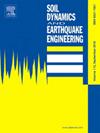相邻钢筋混凝土框架建筑地震动参数与地震间隙距离的关系
IF 4.2
2区 工程技术
Q1 ENGINEERING, GEOLOGICAL
引用次数: 0
摘要
本研究旨在探讨地震动参数(gmp)与相邻中低层钢筋混凝土建筑地震间隙距离的关系。共有22个gmp被考虑为强度测量(IM)输入。除了20个不同的gmp外,每个加速度记录还包括相邻建筑物优势期的频谱加速度值。28个不同的二元建筑模型(三维,3D)在钢筋混凝土建筑中创建,从3层到10层不等。利用22种不同的加速度记录进行了616次非线性时程分析,以获得二元建筑模型之间所需的最小地震间隙距离。研究了gmp与相邻建筑间距的相关性。结果表明,与速度相关的gmp,如Housner烈度(HI)、速度谱烈度(VSI)在估计相邻建筑物的地震间隙距离方面是非常有效的。相邻建筑的谱加速度值也表现出较强的相关性。而加速度、频率和位移相关参数具有中等或较低的相关性。特别是在基于性能的地震工程(PBEE)中经常考虑的参数之一PGA,其相关性较低。本研究开发了基于地面运动参数的方法,可以使用相关度最高的三个gmp来估计相邻建筑物之间的地震间隙值。所得方法的HI、Sa1(T1)和VSI参数的相关值分别为0.91、0.89和0.89。与文献中的DDC方法相比,这些参数具有更高的相关性和更低的误差指标。本研究中提出的基于地面运动参数的方法对现有中低层钢筋混凝土建筑的评估是简单而有用的。本文章由计算机程序翻译,如有差异,请以英文原文为准。
Relationship between ground motion parameters and seismic gap distances of adjacent RC frame buildings
This study aims to investigate the relationships between ground motion parameters (GMPs) and seismic gap distances of adjacent low and mid-rise RC buildings. A total of 22 GMPs were taken into account as Intensity Measures (IM) input. In addition to the 20 different GMPs, the spectral acceleration values of the dominant period of the adjacent buildings were also included for each acceleration record. 28 different binary building models (three dimensional, 3D) were created among reinforced concrete buildings ranging from 3 to 10 stories. 616 nonlinear time history analyses were performed using 22 different acceleration records to obtain the minimum required seismic gap distances between binary building models. The correlation between GMPs and separation distances between neighboring buildings was also investigated. The outcomes show that velocity-related GMPs such as Housner Intensity (HI), Velocity Spectrum Intensity (VSI) are very effective in estimating the seismic gap distances of adjacent buildings. Also, spectral acceleration values of adjacent buildings exhibit strong correlation. Whereas, acceleration, frequency and displacement related parameters have moderate or low correlation. In particular, PGA, one of the frequently considered parameters in performance-based earthquake engineering (PBEE), has a low correlation. This study has developed ground motion parameters-based approaches that can estimate the seismic gap value between adjacent buildings using the three GMPs with the highest correlation values. The correlation values for the proposed approaches for HI, Sa1(T1), and VSI parameters were obtained as 0.91, 0.89 and 0.89, respectively. Compared to the DDC method in the literature, these parameters have higher correlation and lower error metrics. The proposed ground motion parameters-based approaches in this study are simple and useful for the evaluation of existing low and mid-rise RC buildings.
求助全文
通过发布文献求助,成功后即可免费获取论文全文。
去求助
来源期刊

Soil Dynamics and Earthquake Engineering
工程技术-地球科学综合
CiteScore
7.50
自引率
15.00%
发文量
446
审稿时长
8 months
期刊介绍:
The journal aims to encourage and enhance the role of mechanics and other disciplines as they relate to earthquake engineering by providing opportunities for the publication of the work of applied mathematicians, engineers and other applied scientists involved in solving problems closely related to the field of earthquake engineering and geotechnical earthquake engineering.
Emphasis is placed on new concepts and techniques, but case histories will also be published if they enhance the presentation and understanding of new technical concepts.
 求助内容:
求助内容: 应助结果提醒方式:
应助结果提醒方式:


